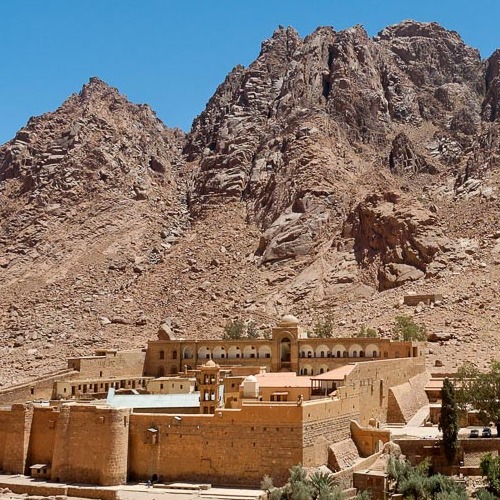Moses Mountain
Moses Mountain “Jebel Musa”
Mount Sinai, also known as Mt. Horeb in the Bible and Jebel Musa locally, is a significant religious site believed to be where Moses received the Ten Commandments. It’s one of Egypt’s highest mountains, featuring a small Orthodox church and a mosque at its summit, 2,285 meters above sea level. The mountain is part of a massif that includes Jebel Safsafa and Jebel Loza, dotted with old churches, gardens, and monastic relics.
The Camel Path and Routes to the Summit The most common route to the peak starts from the Monastery, either via the camel path constructed by Abbas Hilmi Pasha I or the “Steps of Repentance” built by monks. There are also other less-traveled treks. Guides are mandatory for these routes.
Saddle Between Wadi El-Deir and Wadi Isbaiyah This area offers a view into Wadi Isbaiyah, part of an ancient trade route. Here, camel caravans once brought supplies and pilgrims to the Monastery from El-Tur.
Galaktion And Episteme Along the camel path, you can see the Monastery of Saint Episteme and Saint Galaktion, a nun and monk from the fourth century.
Camel Station and Cutting The path to the summit includes a narrow pass cut through the mountain, leading to Elijah’s Basin and the final steps to the summit.
The Summit of Mount Sinai At 2,285 meters, the summit offers a panoramic view, sometimes extending to the Gulfs of Suez and Aqaba. The site is sacred to Christians and Muslims, though Jewish tradition is more reserved about its exact location. The summit features the Church of the Holy Trinity, believed to be built over the rock where God gave Moses the Tablets of the Law.
Elijah’s Basin (Farsh Eliyahu) This area, located between Mount Safsafa and the summit, features ancient trees, a well, and several churches, including the Church of Elijah, commemorating where Elijah spoke with God.
The Stairway of Repentance and Elijah’s Gate The stairway, completed in the 6th century, represents a spiritual and physical challenge, leading to Elijah’s Gate, which dates back to the same era.
Shrive Gate (The Gate of Forgiveness) This gate was historically a place for pilgrims to confess before ascending to the summit.
Chapel of Our Lady of the Steward (Oikonomissa) This chapel commemorates a miraculous event involving the Monastery steward and the Virgin Mary.
Spring of Symeon Located along the descent, this spring is associated with Saint Stephen, who baptized Jews here.
Jebel Loza and Ras Safsafa These mountains form a massif with Mt. Sinai and are home to several historical and religious sites.
Mount Sinai remains a place of deep historical and religious significance, blending natural beauty with ancient traditions and stories.
Created On March 25, 2020
Updated On January 26, 2024



